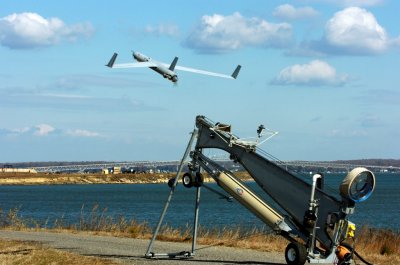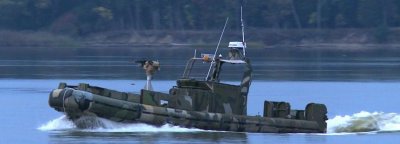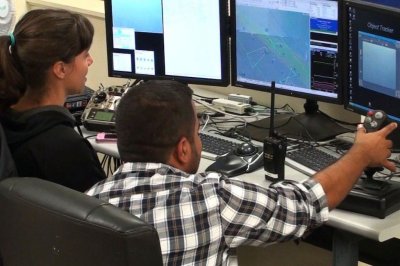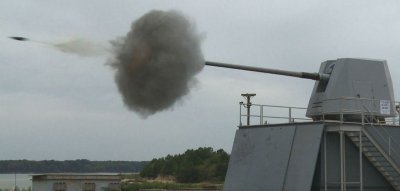
DAHLGREN, Va. - A Scan Eagle unmanned aerial vehicle (UAV) launches from the Naval Surface Warfare Center Dahlgren Division (NSWCDD) Potomac River Test Range. NSWCDD scientists and engineers demonstrated how the science of integration makes surface warfare systems interoperable with unmanned systems - including Scan Eagle UAVs - during a surface warfare integration experiment here, Sept. 29, 2014. Surface warfare officers evaluating the technology joined civilian technologists at the event to prove the Navy can bridge interoperability gaps known as the interstitial space between complex system-of-systems. "Scan Eagle has been deployed on guided missile destroyers for years to provide persistent electro-optical and infrared surveillance," said Cmdr. Marc Williams, surface warfare tactical action officer for the experiment. "It has been used for Naval Surface Fire Support spotting to walk gun rounds onto an enemy target, but not in an automated fashion like in this experiment." (U.S. Navy photo by John Williams/Released)
DAHLGREN, Va. (Oct. 2, 2014)—Navy engineers used technologies supporting the science of integration to guide live gun fire onto distant targets, demonstrating a new integrated surface warfare capability in a maritime environment, Sept. 29.
Military and civilian leaders observed as unmanned surface and air vehicles - integrated with naval guns and the Aegis combat system - relayed targeting data to operators engaging fictitious threats on the Potomac River Test Range.
"This is a major first step in demonstrating an integrated surface warfare capability utilizing unmanned vehicles in support of the key engagement functions of plan, detect, control, engage and assess," said Neil Baron, Naval Surface Warfare Center Dahlgren Division (NSWCDD) distinguished scientist for combat control. "We are working hard at focusing on the integration sciences to deal with mission engineering challenges for surface warfare."
Specifically, Baron and his team of Navy scientists and engineers used the science of integration to make surface warfare systems interoperable with unmanned air and unmanned surface vehicles, enabling streaming identification and shot correction data to naval gunnery throughout the test.

DAHLGREN, Va. - An autonomous unmanned surface vehicle (USV) transmits real-time targeting data to an Aegis weapon system that engaged a target on the Potomac River Test Range with the MK34 5 inch/62 caliber gun weapon system during a surface warfare integration test Sept. 29. The fall of shot - observed by a Scan Eagle Unmanned Air Vehicle (UAV) optical sensor - was used to provide gun targeting corrections immediately to the MK160 gun weapon system operator. Naval Surface Warfare Center Dahlgren Division engineers demonstrated how the science of integration makes surface warfare systems interoperable with USVs and UAVs during the experiment. (U.S. Navy photo by Patrick Dunn/Released)
"It's a spectacular example of how scientists and engineers are enabling new technologies for the warfighter," said Baron.
Surface warfare officers evaluating the technology joined civilian technologists at the event to prove the Navy can bridge interoperability gaps - known as the interstitial space - between complex system-of-systems.
"The ability to send a small, persistent unmanned system down range in hostile territory for real-time gun or missile engagement spotting and targeting is needed by warships," said NSWCDD Engagement Systems Department Military Deputy Cmdr. Marc Williams. "The technology has the potential to be important for surface ships, especially relating to Aegis weapon system, Naval Surface Fire Support, and surface warfare."

DAHLGREN, Va. - Naval Surface Warfare Center Dahlgren Division engineers control a Scan Eagle unmanned air vehicle during a surface warfare integration test Sept. 29. They demonstrated how the science of integration makes surface warfare systems interoperable with unmanned systems. The new interoperability provides streaming identification and shot correction data to naval gunnery controlled by the Aegis weapon system. (U.S. Navy photo by Patrick Dunn/Released)
Williams - the surface warfare tactical action officer for the experiment - ordered a gun engagement on a fictitious threat based on identification and targeting data he saw streaming from an unmanned surface vehicle.
At that point, the commander used a deployed Scan Eagle unmanned aerial vehicle's streaming video data to spot, precisely target, engage and continually support reengagement through gun targeting corrections to the MK160 gun weapon system operator.
"Scan Eagle has been deployed on guided missile destroyers for years to provide persistent electro-optical and infrared surveillance," said Williams, adding that, "it has been used for Naval Surface Fire Support spotting to walk gun rounds onto an enemy target, but not in an automated fashion like in this experiment."

DAHLGREN, Va. - An MK45 5-inch lightweight gun fires on a fictitious threat on the Potomac River Test Range during a surface warfare integration test Sept. 29. Naval Surface Warfare Center Dahlgren Division (NSWCDD) engineers relied on unmanned surface and air vehicles to guide live gun fire onto distant targets, demonstrating a new integrated surface warfare capability in a maritime environment. (U.S. Navy photo by Patrick Dunn/Released)
Moreover, Williams used a Navy technology called Visual Automated Scoring System (VASS) to instantly correct the gun targeting.
The NSWCDD-patented system is an automated, computerized method for determining gunfire miss distances using video data. With a non-line of sight weapon system, VASS allows the gunner to adapt gun pointing angle and converge gunfire onto a target without having to risk the lives of forward observers.
"This was as much a demonstration about integration as it was about the three research initiatives being exercised," said Baron.
The NSWCDD-funded initiatives featured a virtual ship called the USS Dahlgren, VASS adaptive fire control, and new mission engineering efforts to link surface combatant warfare systems with unmanned vehicles.
Throughout the test, the cybernetic USS Dahlgren responded to reports of hostile threats by searching intelligence and data across multiple air and ship control operational systems, maximizing response accuracy and timeliness.
"The virtual USS Dahlgren is hosting new technological advancements and platforms for integrated test and evaluation full speed ahead," said NSWCDD Technical Director Dennis McLaughlin who watched the demonstration. "We are providing linkage that ensures our test and evaluation capabilities can be rapidly adapted to changing warfighter needs."
Bridging the interstitial space between Navy surface combatants, integrated systems, and adaptive fire control is vital to accomplish key fiscal year 2015 Navy objectives - proliferating unmanned systems, integrating unmanned systems into the Navy culture, and developing, fielding, and deploying unmanned systems in the air, on and under the sea, and on the ground.
"The science of integration - a relatively new area of investigation for NSWC Dahlgren Division - hides in the interstitial space," said Baron. "We are working hard at focusing on the integration sciences to deal with mission engineering challenges for surface warfare. These demonstrations are casting a strong light into the interstitial space to address naval interoperability and integration challenges and continue to advance warfighting capabilities into our surface fleet."

